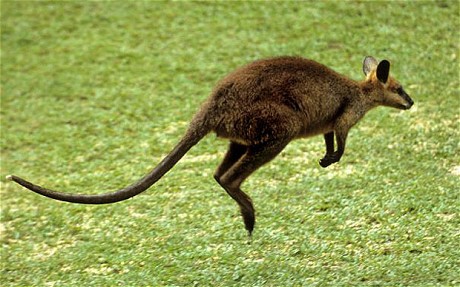科学家通过对沙袋鼠wallaby基因组的测序发现了袋鼠跳跃的起源——一组名为HOX基因,正是这一组基因使袋鼠拥有异常强壮的后肢,从而演化出极具特色的移动方式。

科学家发现与跳跃有关的基因
该研究首次对袋鼠家族中这一物种的基因组进行测序。
科学家可精确定位 HOX 基因簇,它们被认为与动物不同寻常的移动能力有关。
沙袋鼠的基因组允许科学家研究哺乳动物进化中的一个关键点,相关的研究发表Genome Biology 期刊上。
有袋类和胎生类动物大约在1.8亿年前由同一个祖先分化而来。
通过比较有袋类和胎生类动物的基因组,科学家识别出多组有袋类特有的基因。
科学家在沙袋鼠基因组中发现了与气味识别相关的1500个以上的基因,揭示了沙袋鼠为什么能识别广泛的气体。这可能解释沙袋鼠通过母袋鼠皮毛气味准确地找到育儿袋。
在有袋类动物中,沙袋鼠的基因组是第3个被测通的。(生物探索译 Pobee)
生物探索推荐英文原文
Strewth, scientists discover how the kangaroo got its hop
Scientists have discovered the origin of the kangaroo's hop after sequencing the genome of a type of wallaby.
The project is the first time the genome of a species belonging to the kangaroo family has been sequenced.
It has allowed researchers to pinpoint a cluster of genes they believe are responsible for the animals' unusual form of locomotion.
The tammar wallaby genome, which is published in the journal of Genome Biology, will also provide scientists with the ability to study a key point in mammalian evolution.
Marsupials and placental animals, which include humans, diverged from a common ancestor around 180 million years ago.
By comparing the wallaby genome with those of placental mammals, the scientists have been able to identify several groups of genes that are unique to marsupials.
The tammar genome contains one of the largest families of genes required for detecting smell compared to other mammals. The scientists found it has more than 1,500 genes responsible for detecting smells.
It suggests the tammar wallaby can detect a wide range of odours, which might help explain how the tiny bean-sized newborn wallaby can navigate it's way through its mother's fur to her pouch where it remains for nine months as it grows.
"The tammar wallaby sequencing project has provided us with many possibilities for understanding how marsupials are so different to us," explained Professor Marilyn Renfree, from the University of Melbourne, who was one of the lead researchers on the project.
The rabbit-sized tammar wallaby is the third marsupial to have its genome sequenced, after the grey short-tailed opossum and the endangered Tasmanian devil.
The project was conducted by an international consortium of scientists from Australia, USA, Japan, the UK and Germany.
The researchers have identified cluster of genes called HOX are key to the development of the animals' enlarged, powerful hind-legs and its distinctive hop, which is common among members of the kangaroo family.
Dr Elizabeth Murchison, a marsupial specialist at the Wellcome Trust Sanger Institute in Cambridge, UK, described the study as "an impressive piece of work looking at one of Australia's iconic species."
Speaking to BBC News, she said: "It's always really valuable to look at an organism that is a bit different to understand how humans and other mammals have evolved.
"It gives you a perspective on mammalian evolution by looking at mammals that have diverged fairly early on, like the kangaroo."







